Wood Extractives of Silver Fir and Their Antioxidant and Antifungal Properties
Abstract
:1. Introduction
2. Materials and Methods
2.1. Extraction
2.2. Spectrophotometric Analysis
2.3. Chromatographic Analysis
2.3.1. Thin Layer Chromatography
2.3.2. Reversed-Phase High-Performance Liquid Chromatography (RP-HPLC)
2.4. In Vitro Antifungal and Antimicrobial Assay
2.5. Determination of Antioxidant Potential by the DPPH Method
2.6. Statistics
3. Results and Discussion
3.1. Contents of Lipophilic and Hydrophilic Extractives and Total Phenols
3.2. Chemical Identities of Phenolic Extractives of Silver Fir Wood
3.3. Antifungal and Antioxidant Properties of Knotwood and Branchwood Extracts of Silver Fir
3.3.1. In Vitro Growth Inhibition of Selected Fungi and Molds by Extractives from Knotwood and Branchwood of Silver Fir
3.3.2. Antioxidant Potential of Silver Fir Knotwood and Branchwood Extracts
4. Conclusions
Author Contributions
Funding
Institutional Review Board Statement
Informed Consent Statement
Data Availability Statement
Acknowledgments
Conflicts of Interest
Sample Availability
References
- Willför, S.; Nisula, L.; Hemming, J.; Reunanen, M.; Holmbom, B. Bioactive phenolic substances in industrially important tree species. Part 1: Knots and stemwood of different spruce species. Holzforschung 2004, 58, 335–344. [Google Scholar] [CrossRef]
- Willför, S.; Nisula, L.; Hemming, J.; Reunanen, M.; Holmbom, B. Bioactive phenolic substances in industrially important tree species. Part 2: Knots and stemwood of fir species. Holzforschung 2004, 58, 650–659. [Google Scholar] [CrossRef]
- Holmbom, B. Extraction and utilisation of non-structural wood and bark components. In Biorefining of Forest Resources; Alén, R., Ed.; Paper Engineers’; Association/Paperi ja Puu Oy: Helsinki, Finland, 2011; pp. 178–224. [Google Scholar]
- Hofmann, T.; Albert, L.; Retfalvi, T. Quantitative TLC analysis of (+)-catechin and (-)-epicatechin from Fagus sylvatica L. with and without red heartwood. J. Planar Chromatogr. 2004, 17, 350–354. [Google Scholar] [CrossRef]
- Dobrowolska, D.; Boncina, A.; Klumpp, R. Ecology and silviculture of silver fir (Abies alba Mill.): A review. J. For. Res. 2017, 22, 326–335. [Google Scholar] [CrossRef]
- Willför, S.; Reunanen, M.; Eklund, P.; Sjoholm, R.; Kronberg, L.; Fardim, P.; Pietarinen, S.; Holmbom, B. Oligolignans in Norway spruce and Scots pine knots and Norway spruce stemwood. Holzforschung 2004, 58, 345–354. [Google Scholar] [CrossRef]
- Kebbi-Benkeder, Z.; Manso, R.; Gérardin, P.; Dumarçay, S.; Chopard, B.; Colin, F. Knot extractives: A model for analysing the eco-physiological factors that control the within and between-tree variability. Trees 2017, 31, 1619–1633. [Google Scholar] [CrossRef]
- Tavčar Benković, E.; Žigon, D.; Mihailović, V.; Petelinc, T.; Jamnik, P.; Kreft, S. Identification, in vitro and in vivo antioxidant activity, and gastrointestinal stability of lignans from silver fir (Abies alba) wood extract. J. Wood Chem. Technol. 2017, 1–11. [Google Scholar] [CrossRef]
- Willför, S.; Hemming, J.; Reunanen, M.; Eckerman, C.; Holmbom, B. Lignans and lipophilic extractives in Norway spruce knots and stemwood. Holzforschung 2003, 57, 27–36. [Google Scholar] [CrossRef]
- Fengel, D.; Wegener, G. Wood: Chemistry, Ultrastructure, Reactions; Walter de Gruyter: Berlin, Germany; New York, NY, USA, 1989; p. 613. [Google Scholar] [CrossRef]
- Vek, V.; Poljanšek, I.; Oven, P. Variability in content of hydrophilic extractives and individual phenolic compounds in black locust stem. Eur. J. Wood Wood Prod. 2020, 78, 501–511. [Google Scholar] [CrossRef] [Green Version]
- Brennan, M.; Hentges, D.; Cosgun, S.; Dumarcay, S.; Colin, F.; Gérardin, C.; Gérardin, P. Intraspecific variability of quantity and chemical composition of ethanolic knotwood extracts along the stems of three industrially important softwood species: Abies alba, Picea abies and Pseudotsuga menziesii. Holzforschung 2021, 75, 168–179. [Google Scholar] [CrossRef]
- Hamada, J.; Petrissans, A.; Ruelle, J.; Mothe, F.; Colin, F.; Petrissans, M.; Gerardin, P. Thermal stability of Abies alba wood according to its radial position and forest management. Eur. J. Wood Wood Prod. 2018, 76, 1669–1676. [Google Scholar] [CrossRef]
- Morris, H.; Hietala, A.M.; Jansen, S.; Ribera, J.; Rosner, S.; Salmeia, K.A.; Schwarze, F.W.M.R. Using the CODIT model to explain secondary metabolites of xylem in defence systems of temperate trees against decay fungi. Ann. Bot. 2019, 125, 701–720. [Google Scholar] [CrossRef] [PubMed]
- Pietarinen, S.; Willför, S.; Ahotupa, M.; Hemming, J.; Holmbom, B. Knotwood and bark extracts: Strong antioxidants from waste materials. J. Wood Sci./J. Wood Sci. 2006, 52, 436–444. [Google Scholar] [CrossRef]
- Drevenšek, G.; Lunder, M.; Benković, E.T.; Štrukelj, B.; Kreft, S. Cardioprotective effects of silver fir (Abies alba) extract in ischemic-reperfused isolated rat hearts. Food Nutr. Res. 2016, 60, 7. [Google Scholar] [CrossRef] [Green Version]
- Plumed-Ferrer, C.; Väkeväinen, K.; Komulainen, H.; Rautiainen, M.; Smeds, A.; Raitanen, J.E.; Eklund, P.; Willför, S.; Alakomi, H.L.; Saarela, M.; et al. The antimicrobial effects of wood-associated polyphenols on food pathogens and spoilage organisms (vol 164, pg 99, 2013). Int. J. Food Microbiol. 2013, 166, 163. [Google Scholar] [CrossRef]
- Vek, V.; Balzano, A.; Poljansek, I.; Humar, M.; Oven, P. Improving Fungal Decay Resistance of Less Durable Sapwood by Impregnation with Scots Pine Knotwood and Black Locust Heartwood Hydrophilic Extractives with Antifungal or Antioxidant Properties. Forests 2020, 11, 1024. [Google Scholar] [CrossRef]
- Kutnar, L.; Kobler, A. Sedanje stanje razširjenosti robinije (Robinia pseudoacacia L.) v Sloveniji in napovedi za prihodnost. Acta Silvae Et Ligni 2013, 21–30. [Google Scholar] [CrossRef] [Green Version]
- Willför, S.M.; Ahotupa, M.O.; Hemming, J.E.; Reunanen, M.H.T.; Eklund, P.C.; Sjoholm, R.E.; Eckerman, C.S.E.; Pohjamo, S.P.; Holmbom, M.R. Antioxidant activity of knotwood extractives and phenolic compounds of selected tree species. J. Agric. Food Chem. / J. Agric. Food Chem. 2003, 51, 7600–7606. [Google Scholar] [CrossRef] [PubMed]
- Välimaa, A.-L.; Honkalampi-Hämäläinen, U.; Pietarinen, S.; Willför, S.; Holmbom, B.; von Wright, A. Antimicrobial and cytotoxic knotwood extracts and related pure compounds and their effects on food-associated microorganisms. Int. J. Food Microbiol. 2007, 115, 235–243. [Google Scholar] [CrossRef] [PubMed]
- Vek, V.; Poljanšek, I.; Oven, P. Efficiency of three conventional methods for extraction of dihydrorobinetin and robinetin from wood of black locust. Eur. J. Wood Wood Prod. 2019, 77, 891–901. [Google Scholar] [CrossRef]
- Singleton, V.L.; Rossi, J.A., Jr. Colorimetry of total phenolics with phosphomolybdic-phosphotungstic acid reagents. Am. J. Enol. Vitic. 1965, 16, 144–158. [Google Scholar]
- Vek, V.; Poljansek, I.; Humar, M.; Willfor, S.; Oven, P. In vitro inhibition of extractives from knotwood of Scots pine (Pinus sylvestris) and black pine (Pinus nigra) on growth of Schizophyllum commune, Trametes versicolor, Gloeophyllum trabeum and Fibroporia vaillantii. Wood Sci. Technol. 2020, 54, 1645–1662. [Google Scholar] [CrossRef]
- Chen, P.-S.; Chen, Y.-H.; Yeh, T.-F.; Chang, S.-T. Mechanism of decay resistance of heartwood extracts from Acacia confusa against the brown-rot fungus Laetiporus sulphureus. Wood Sci. Technol. 2014, 48, 451–465. [Google Scholar] [CrossRef]
- Willför, S.M.; Smeds, A.I.; Holmbom, B.R. Chromatographic analysis of lignans. J. Chromatogr. A 2006, 1112, 64–77. [Google Scholar] [CrossRef] [PubMed]
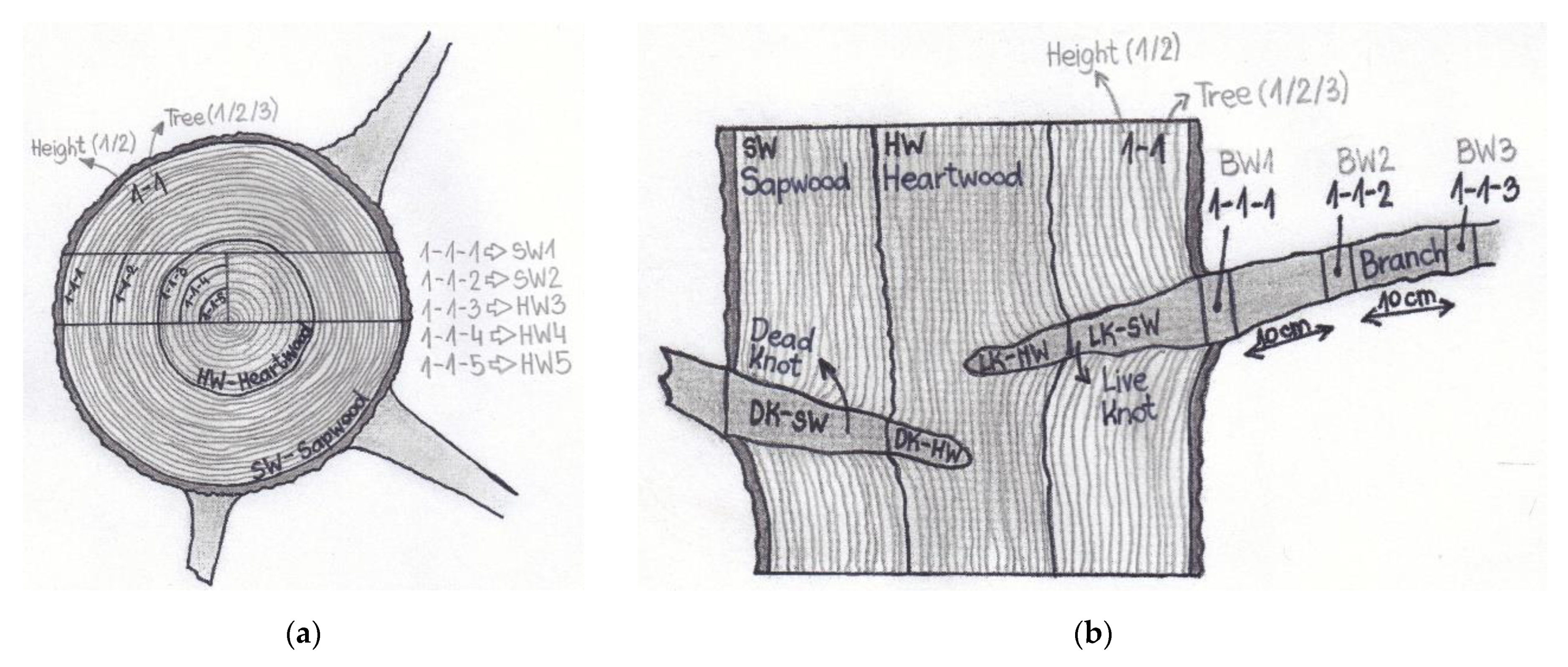
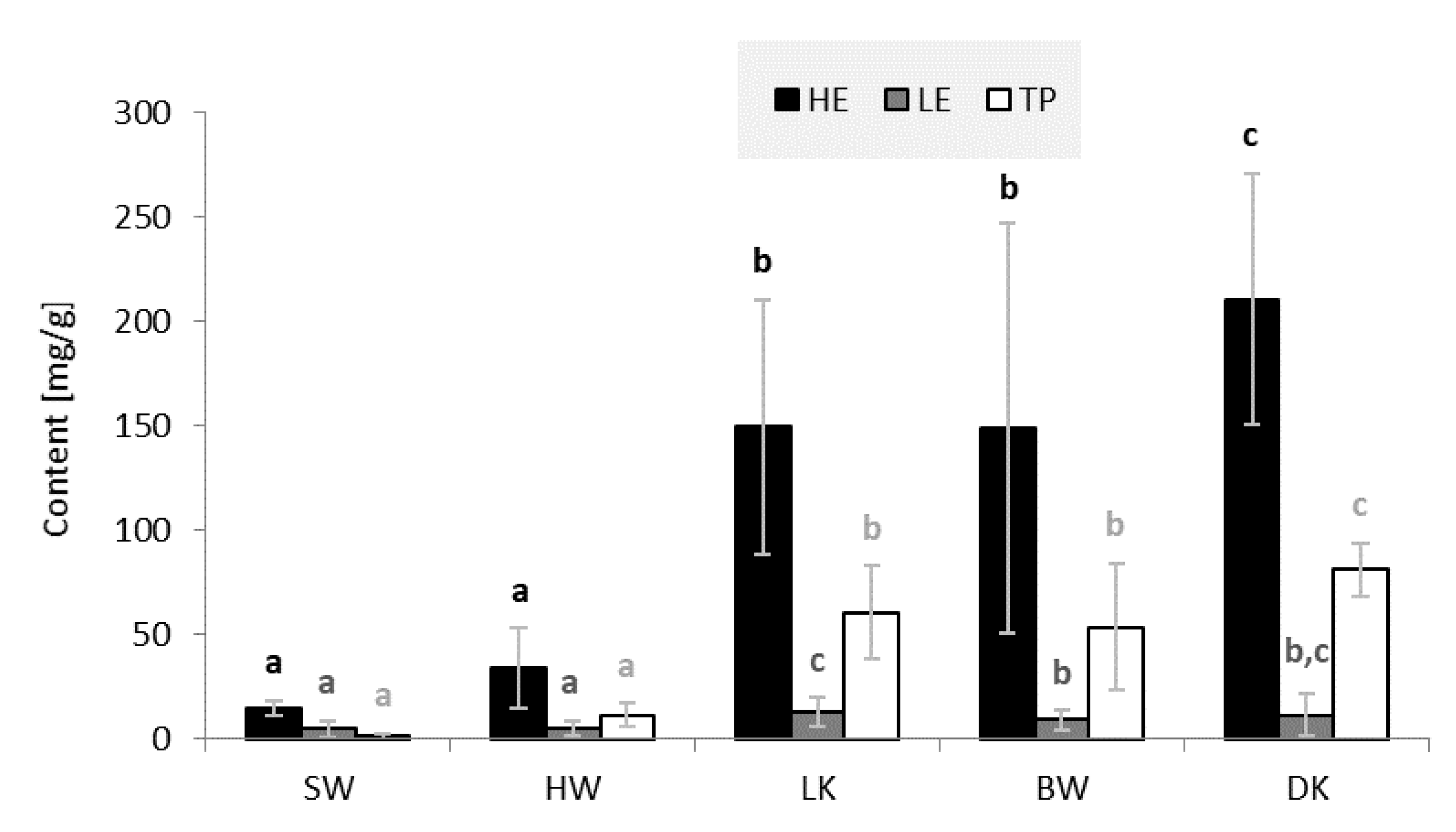
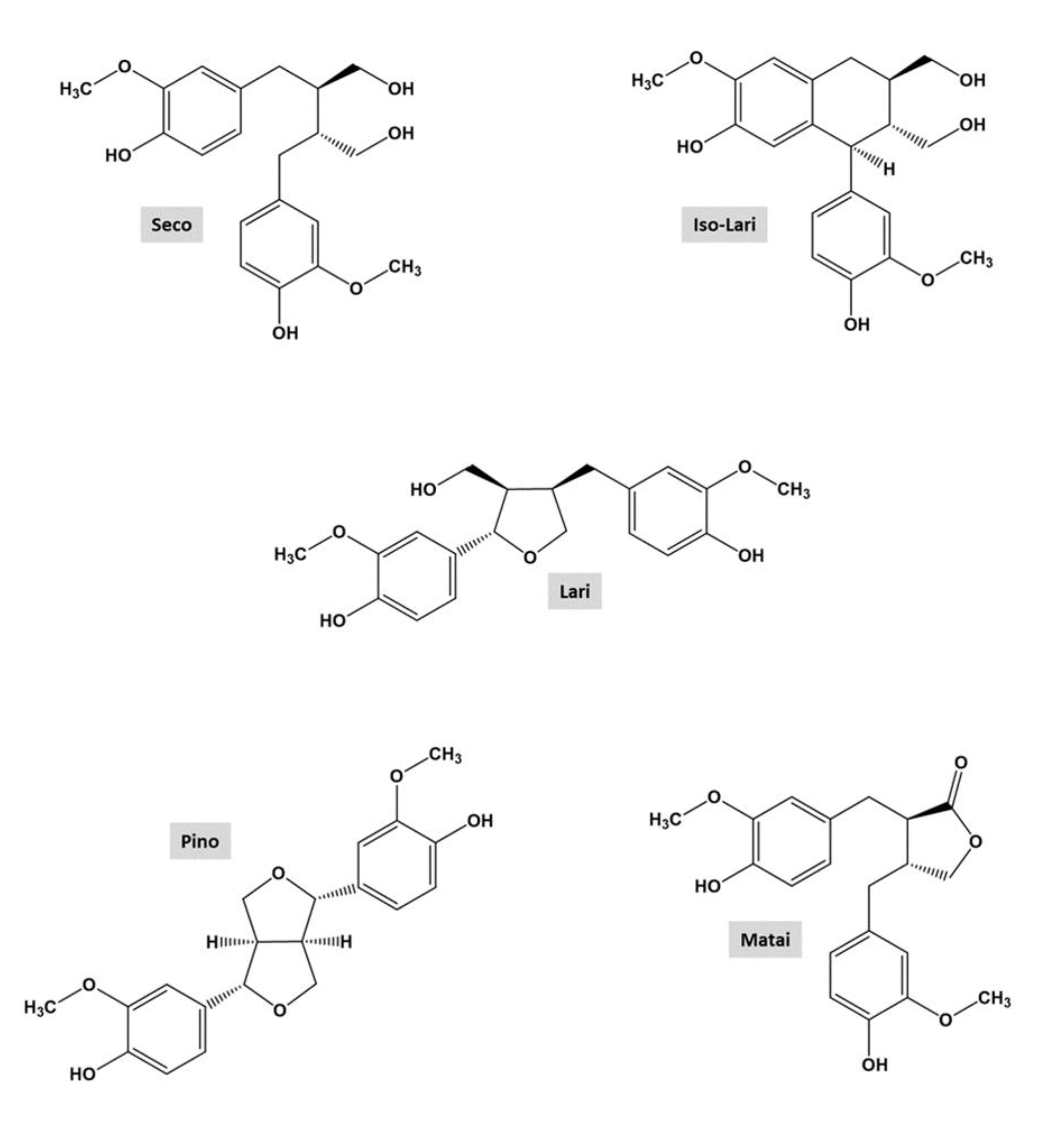

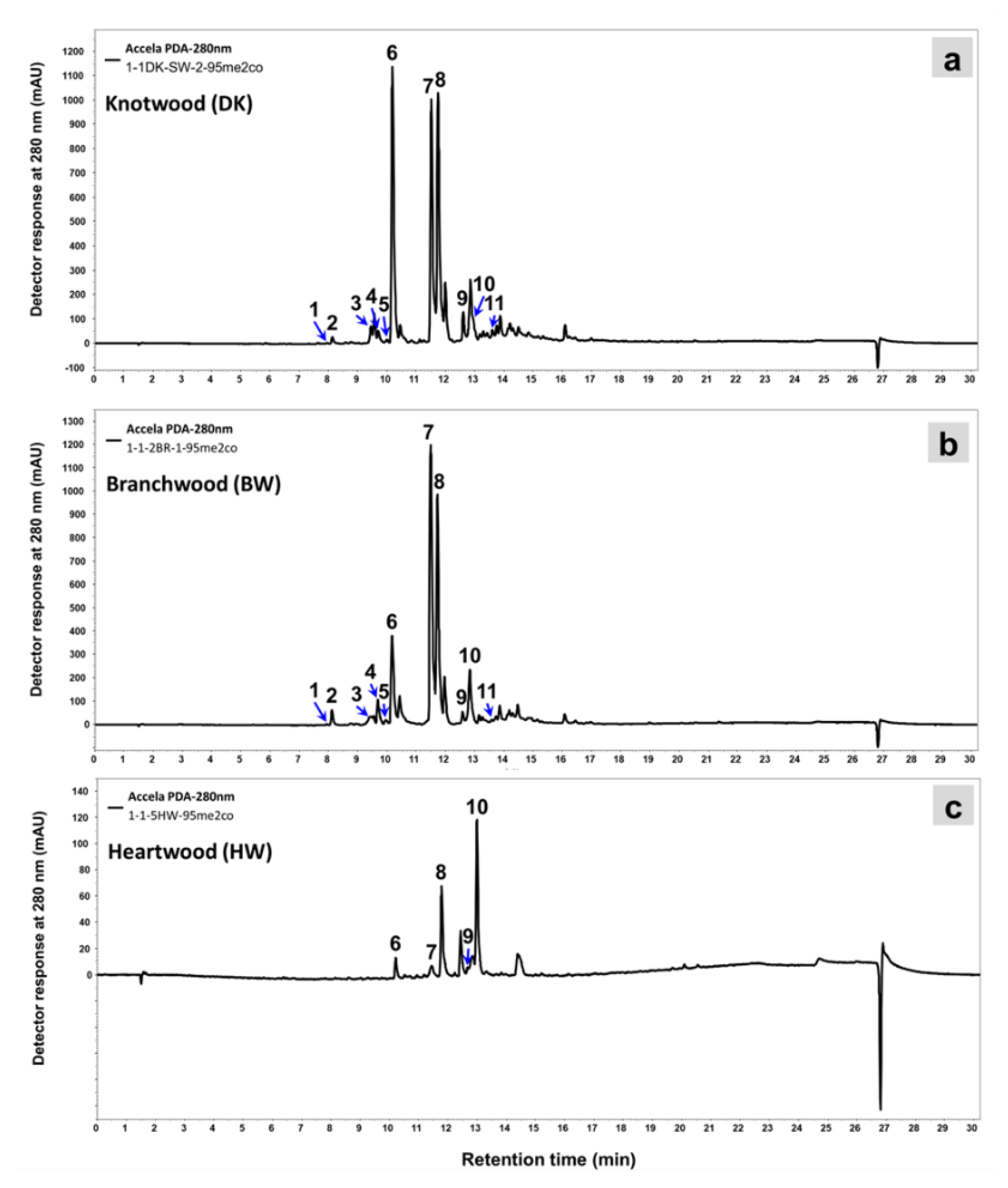
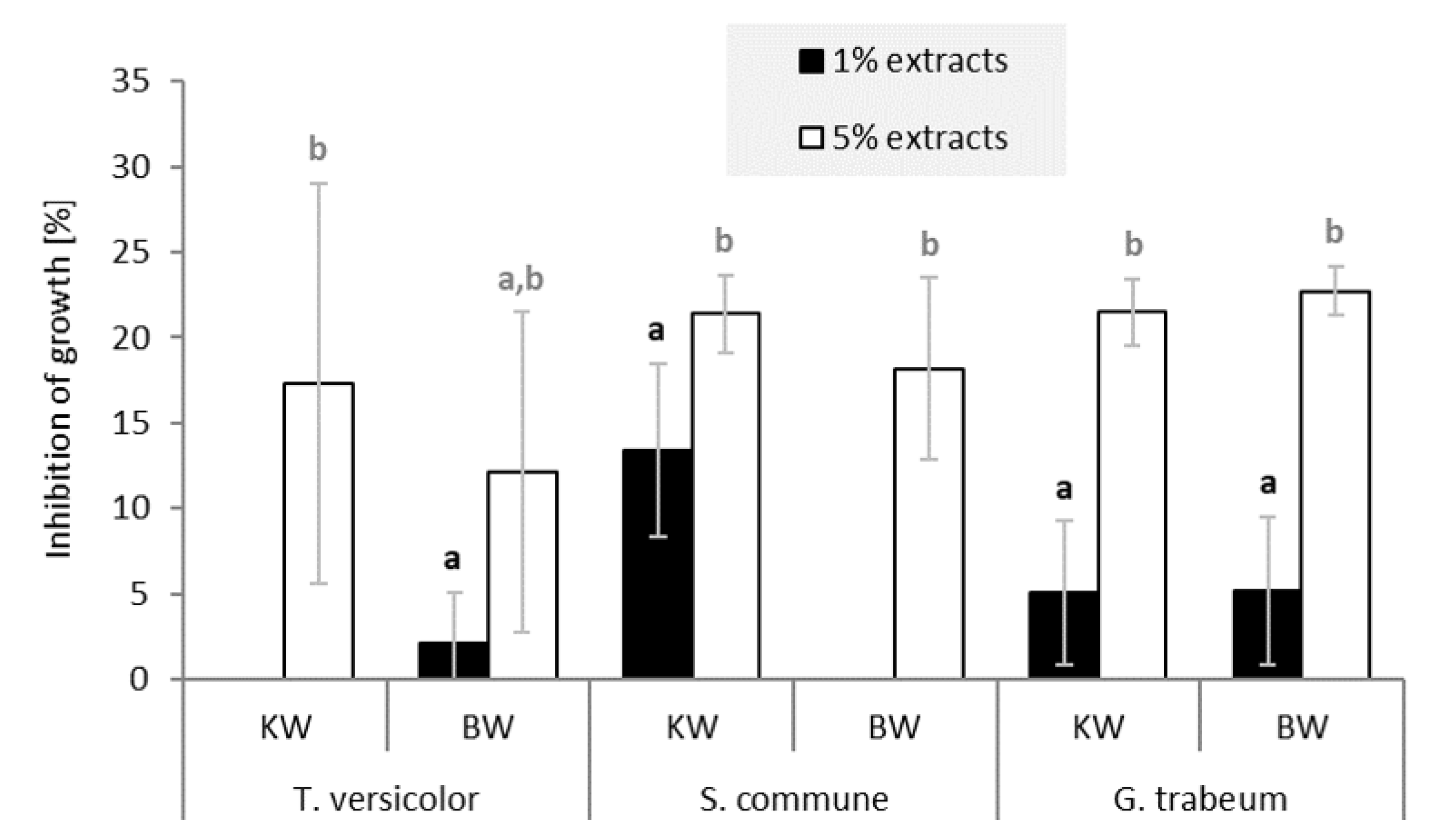
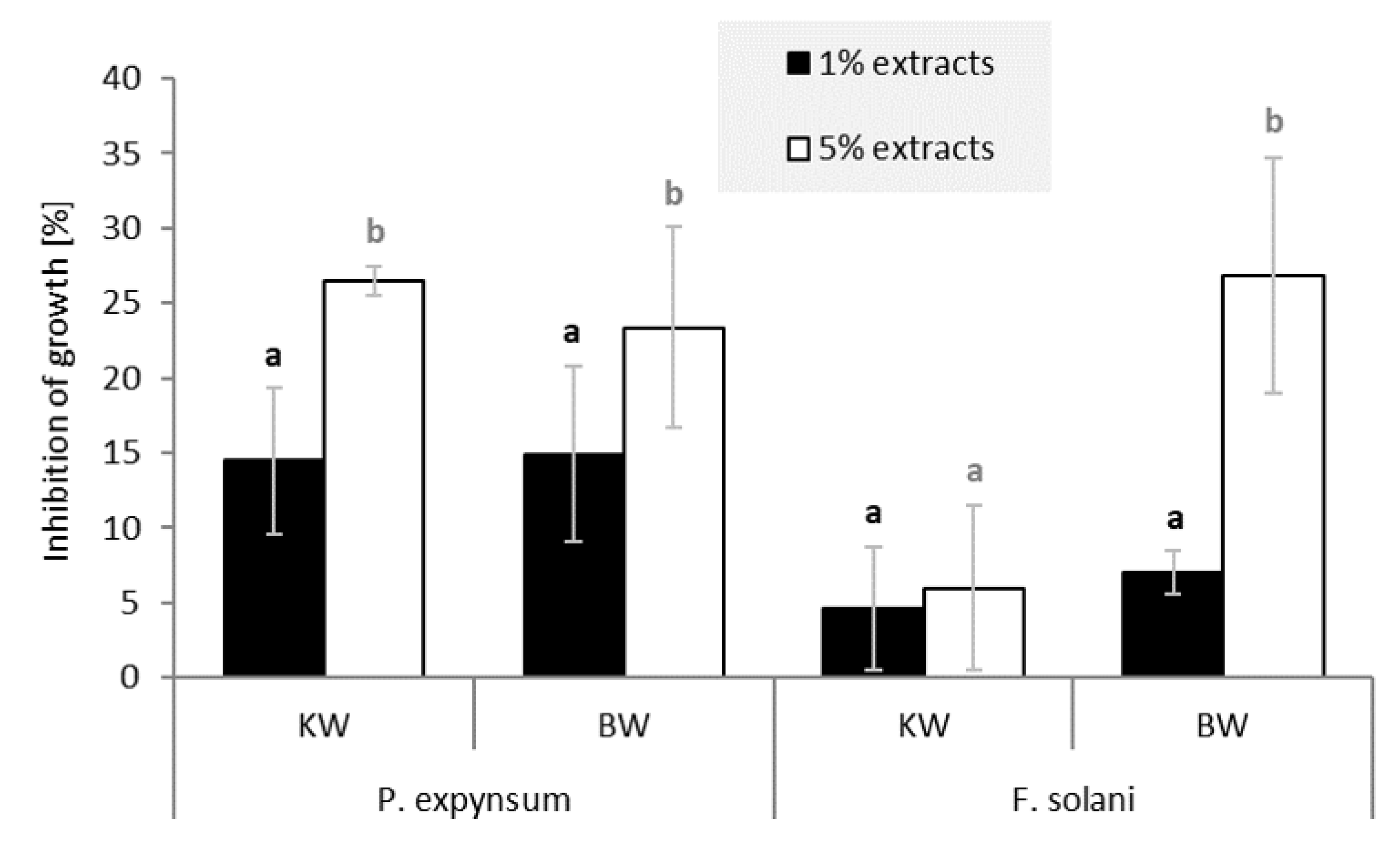

| Sample Disc | Sampling Height (m) | Tree Diameter (with Bark) (cm) | Heartwood Diameter (cm) | Age | Age of Heartwood |
|---|---|---|---|---|---|
| 1-1 | 12 | 28.90 | 18.95 | 64 | 38 |
| 2-1 | 16 | 23.75 | 13.2 | 55 | 27 |
| 1-2 | 7 | 39.15 | 22.3 | 61 | 39 |
| 2-2 | 16 | 28.10 | 13.9 | 39 | 21 |
| 1-3 | 13 | 40.70 | 28.75 | 62 | 47 |
| 2-3 | 21 | 25.75 | 9.9 | 31 | 14 |
| Spot | Average Retention Factor (RF) | Compound | Retention Factor of Standards (RF) |
|---|---|---|---|
| A | 0.41 | Isolariciresinol | 0.42 |
| B | 0.46 | Secoisolariciresinol | 0.46 |
| C | 0.55 | Lariciresinol | 0.53 |
| D | 0.70 | Matairesinol | 0.70 |
| E | 0.71 | Pinoresinol | 0.72 |
| SW | HW | LK | BW | DK | |||||||||
|---|---|---|---|---|---|---|---|---|---|---|---|---|---|
| No. | 1 | 2 | 3 | 4 | 5 | HW | SW | 0 | 10 | 20 | HW | SW | |
| TE [mg/g] | 20.4 (5.4) | 18.8 (7.6) | 49.0 (21.9) | 37.6 (22.4) | 31.4 (16.7) | 128.3 (40.3) | 196.9 (51.7) | 258.9 (71.7) | 151.4 (97.3) | 74.8 (33.3) | 179.3 (44.0) | 281.7 (25.5) | |
| TP [mg/g] | 1.7 (1.7) | 0.9 (1.2) | 13.8 (5.6) | 11.2 (6.4) | 10.0 (4.0) | 50.7 (18.8) | 70.4 (21.7) | 79.8 (21.0) | 54.8 (29.3) | 29.0 (13.8) | 56.4 (37.7) | 86.3 (11.0) | |
| 1 | Epi [mg/g] | 0.1 (0.0) | * ND (0.0) | * ND (0.0) | * ND (0.0) | * ND (0.0) | * ND (0.0) | 0.1 (0.0) | 0.1 (0.0) | 0.1 (0.0) | 0.1 (0.0) | * ND (0.0) | 0.1 (0.0) |
| 2 | HVA [mg/g] | * ND (0.0) | * ND (0.0) | 0.7 (0.3) | 0.3 (0.4) | 0.3 (0.2) | 1.3 (0.6) | 2.2 (0.6) | 2.3 (0.9) | 1.8 (1.1) | 1.0 (0.8) | 1.5 (1.1) | 1.5 (0.3) |
| 3 | CA [mg/g] | * ND (0.0) | * ND (0.0) | 0.4 (0.2) | 0.2 (0.2) | 0.2 (0.2) | 0.5 (0.3) | 0.3 (0.2) | 0.1 (0.1) | 0.1 (0.1) | 0.2 (0.2) | 0.2 (0.3) | 0.5 (0.2) |
| 4 | Tax [mg/g] | * ND (0.0) | * ND (0.0) | 0.2 (0.1) | 0.1 (0.1) | 0.1 (0.0) | 0.5 (0.3) | 0.9 (0.3) | 1.2 (0.5) | 0.8 (0.5) | 0.4 (0.2) | 0.6 (0.4) | 0.5 (0.1) |
| 5 | Fer [mg/g] | * ND (0.0) | * ND (0.0) | 0.1 (0.1) | 0.0 (0.0) | 0.0 (0.0) | 0.1 (0.1) | 0.2 (0.1) | 0.2 (0.1) | 0.1 (0.1) | 0.1 (0.1) | 0.1 (0.1) | 0.1 (0.0) |
| 6 | Iso-Lari [mg/g] | * ND (0.0) | * ND (0.0) | 1.0 (1.1) | 0.5 (0.3) | 0.6 (0.4) | 7.2 (6.5) | 20.1 (14.4) | 24.5 (17.9) | 13.9 (11.6) | 7.9 (13.9) | 15.3 (8.9) | 46.9 (35.1) |
| 7 | Lari [mg/g] | * ND (0.0) | * ND (0.0) | 0.4 (0.4) | 0.2 (0.2) | 0.5 (0.7) | 8.5 (7.9) | 26.1 (17.8) | 32.3 (20.8) | 22.5 (17.5) | 11.0 (13.3) | 25.4 (15.7) | 25.9 (15.2) |
| 8 | Seco [mg/g] | 0.1 (0.0) | 0.1 (0.1) | 0.2 (0.1) | 0.4 (0.3) | 0.7 (0.7) | 12.9 (9.3) | 29.8 (16.1) | 37.6 (22.1) | 22.8 (15.8) | 11.2 (8.9) | 19.3 (10.7) | 21.3 (13.1) |
| 9 | Pino [mg/g] | 0.1 (0.0) | * ND (0.0) | * ND (0.0) | * ND (0.0) | * ND (0.0) | 0.7 (0.4) | 1.7 (0.9) | 2.0 (1.0) | 1.1 (0.7) | 0.6 (0.7) | 1.2 (0.6) | 2.5 (1.6) |
| 10 | Matai [mg/g] | * ND (0.0) | * ND (0.0) | 0.6 (0.5) | 1.5 (1.2) | 1.6 (1.3) | 4.6 (2.6) | 7.8 (4.5) | 10.0 (5.5) | 6.1 (3.9) | 3.5 (3.0) | 6.7 (4.0) | 8.2 (4.9) |
| 11 | Qur [mg/g] | * ND (0.0) | * ND (0.0) | * ND (0.0) | * ND (0.0) | * ND (0.0) | 0.2 (0.2) | 0.4 (0.3) | 0.6 (0.3) | 0.3 (0.2) | 0.1 (0.5) | 0.7 (0.4) | 1.4 (0.7) |
Publisher’s Note: MDPI stays neutral with regard to jurisdictional claims in published maps and institutional affiliations. |
© 2021 by the authors. Licensee MDPI, Basel, Switzerland. This article is an open access article distributed under the terms and conditions of the Creative Commons Attribution (CC BY) license (https://creativecommons.org/licenses/by/4.0/).
Share and Cite
Vek, V.; Keržič, E.; Poljanšek, I.; Eklund, P.; Humar, M.; Oven, P. Wood Extractives of Silver Fir and Their Antioxidant and Antifungal Properties. Molecules 2021, 26, 6412. https://doi.org/10.3390/molecules26216412
Vek V, Keržič E, Poljanšek I, Eklund P, Humar M, Oven P. Wood Extractives of Silver Fir and Their Antioxidant and Antifungal Properties. Molecules. 2021; 26(21):6412. https://doi.org/10.3390/molecules26216412
Chicago/Turabian StyleVek, Viljem, Eli Keržič, Ida Poljanšek, Patrik Eklund, Miha Humar, and Primož Oven. 2021. "Wood Extractives of Silver Fir and Their Antioxidant and Antifungal Properties" Molecules 26, no. 21: 6412. https://doi.org/10.3390/molecules26216412
APA StyleVek, V., Keržič, E., Poljanšek, I., Eklund, P., Humar, M., & Oven, P. (2021). Wood Extractives of Silver Fir and Their Antioxidant and Antifungal Properties. Molecules, 26(21), 6412. https://doi.org/10.3390/molecules26216412







